Read Reviews
The Best Pond Pumps
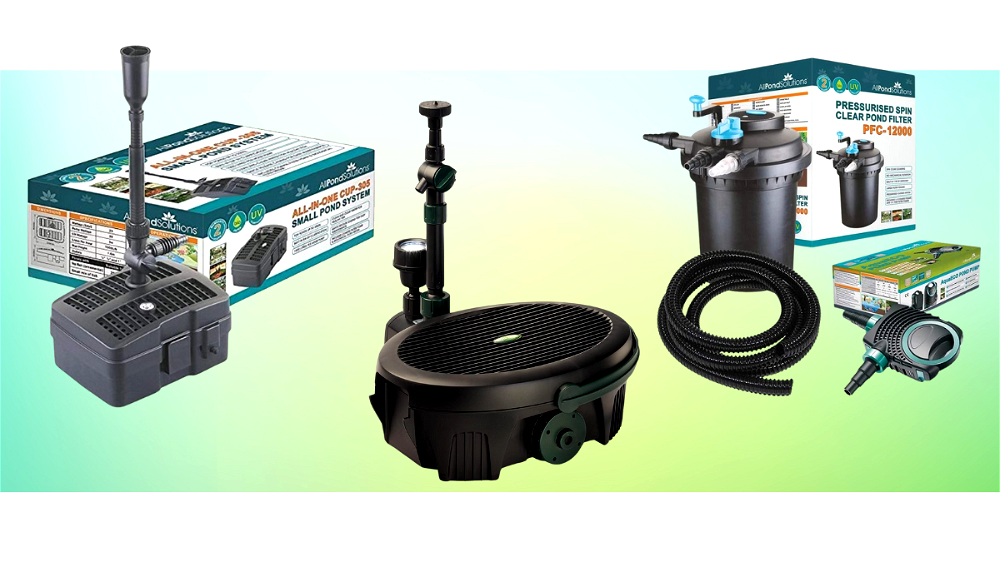
-
Best small pond pump - AllPondSolutions CUP-305 All in One Pond Pump Filter
-
Best for medium ponds - Blagdon Inpond 5-in-1 3000, 10w Pond Pump
-
Best for koi ponds - Pressurised Koi Fish Pond Filter & Pump Kit
-
Best value for money - Hozelock 3003 Easyclear 3000 Pond Fountain Pump
-
Best for versatility - Blagdon 3500 Midipond Filter & Pump
-
Best for low energy usage - Jebao XTP-10000 Compact Eco Pond Filter Pump
-
Best for wildlife protection - Hozelock 1581 Aquaforce 2500 Pond Pump
Pond Pump Reviews
1. AllPondSolutions CUP-305 All in One Pond Pump Filter
Best small pond pump
- Most users find their pond is clear within just 7 days
- Comes with three fountain heads to suit your style of garden
- Can be put together and installed in around 15 minutes
- Compact and neat - doesn’t take up much space in your pond
- Some customers commented that the UV light wasn’t strong enough to have much effect
- Filters initially need cleaning every day
- Max. Capacity
- 4000L
- Max. Flow Rate
- 2500L/h
- Power Source
- Mains
- Pumping Height
- 2.5m
- Cable Length
- 10m
- Performance
- 5
- Features
- 5
- Efficiency
- 4.5
- Value for Money
- 4.5
Setting up pond filter systems isn’t always straight forward, but fortunately there’s very little preparation or effort required when fitting this AllPondSolutions CUP-305 into the pond.
It’s a single unit with just one power cable (10 metres long) which makes a change from other pond pumps that can have multiple wires, units, and connectors. It also has filter medium included, so there’s no need to buy a filter separately to the pump. The flow rate is 2000 L per hour.
If you have a waterfall feature, this is one of the best pumps for managing the flow of water around the pond between different elements. There’s a splitter included that allows the circulating water to be divided between a waterfall feature and the pond, and the flow rate of water sent through either course can be controlled.
Three fountain heads also come included, which attach to the top of this submersible pond pump and turn it into a water feature itself, keeping water moving. It’s primarily suitable for small to medium ponds, up to 2500 L or ornamental ponds up to 4000 L.
There are several filters included too: a coarse foam filter and three filter-media baskets. The first two baskets are filled with ceramic biological media and the last with a K1 media.
Within a few days it’s possible to see the results of these filters working, and the water clearing. Once you can see into the depths of your pond again, you may even find some fish you didn’t know you had!
Like many of the pond pumps featured on this page, it makes use of a UVC lamp, utilising UV light to kill algae as the water is filtered. However, the UV bulb is 11 watts which is slightly more powerful than others.
Overall, this seems to be a great option for those who like ponds with aesthetic elements. It’s a useful waterfall pump that can send a controlled amount of water over a waterfall whilst creating an attractive fountain in the middle of the pond. Plus, it helps the pond water become visibly clearer.
Did you find this review helpful?
2. Blagdon Inpond 5-in-1 3000, 10w Pond Pump[ SAVE 22% ]
Best for medium ponds
- The polymer wool pad cartridge effectively removes very small particles
- A difference to pond water clarity can be seen in just a few days
- Good choice for beginners as easy to assemble and clean
- Filters can be easily cleaned with rain water or garden hose
- Choice of three fountain heads
- Two outdoor plug sockets are required
- Two plugs are required, to attach to the power cables, and they don't come included
- Max. Capacity
- 3000L
- Max. Flow Rate
- 700L/h
- Power Source
- Mains
- Pumping Height
- 1.25m
- Cable Length
- 10m
- Performance
- 5
- Features
- 5
- Efficiency
- 4.5
- Value for Money
- 4
As it turns out, there’s a lot more to pond filtration systems than simply cleaning grubby water. This Blagdon Inpond 5-in-1 3000 offers five different functions in one unit, these range from filters to fountains. It has a maximum flow rate of 700 L per hour.
Not only does it work well as a pond pump and filter to keep water clean, it also uses UV to kill algae, creates a stunning fountain, and makes use of LED bulbs to transform into a light feature after dark. A particularly nice feature with the light is that it can be programmed to only come on at night. Having said this, setting it up may take a bit of experimentation as the instructions aren’t very detailed.
There are three fountain heads to choose from, to create a ‘super daisy’, ‘single daisy’ or ‘waterbell’ fountain.
The filtration system uses a combination of coarse/medium foam and ceramic bio-media, as well as a polymer wool pad cartridge to remove debris and clean the water. Within one week the filter can clear the water so that it’s possible to see the bottom of even a 60 cm pond.
One thing that might be a little misleading, is the amount of water this submersible pump can filter – despite the model name being ‘3000’, it is only suitable for filtering 700 L of water an hour. Therefore, it’s only appropriate for small-medium ponds. This is worth being aware of – due to its name it could easily be mistaken as more powerful than other pond pumps.
As an example, a pond that is approximately 140 cm long, 100 cm wide and 50 cm deep would have a capacity of about 700 L.
Another thing to be aware of is that you will need to fit plugs onto both the power cable for the pump and the UV base unit. The plugs aren’t included, so this is something that needs to be sourced before the system can be used.
Overall, this is one of the best pond pumps for offering aesthetic water features as well as working well to clean the water. It’s inexpensive, especially considering everything it can do, but it does require a fair amount of maintenance to keep the filters clean and the pump working.
Did you find this review helpful?
3. Pressurised Koi Fish Pond Filter & Pump Kit
Best for koi ponds
- Produces quick results with most users noticing their pond looks clearer within 24 hours
- As an all-in-one kit, there are no separate purchases needed
- Easy method of cleaning the filters by turning side handle
- Can turn even green pond water to clear water within a couple of weeks
- Surprisingly quiet given the power
- Blanket weed can clog the filters, so should be kept under control by other means
- The 5 m hose supplied may be a little short for some gardens, depending on the pond set up
- Max. Capacity
- 12000L
- Max. Flow Rate
- 10000L/h
- Power Source
- Mains
- Pumping Height
- 5.6m
- Cable Length
- 5m (filter); 10m (pump)
- Performance
- 4.5
- Features
- 5
- Efficiency
- 3.5
- Value for Money
- 4
This Pressurised Koi Fish Pond Filter is suitable for relatively large ponds and cleans them using a combination of a filtering system and UV light.
Depending on what type of pond it is, this pond pump has slightly different cleaning capabilities. For a heavily-stocked Koi pond, it can clean up to 6000 L of water; for ponds stocked with a small amount of fish/Koi it will clean up to 9000 L; and for decorative ponds it can filter up to 12,000 L. Its one of the most powerful pond pumps featured here, but its performance is very much based on the function of the pond as well as its size.
For dirty, green, cloudy fish ponds of roughly 4500 L, a difference in the water can be noticed within one week of using the filter, and in less than six weeks it can have the water completely clear.
In terms of value, this pond pump almost half the price of some other filters yet offers a similar service. It’s not a submersible pump though, unlike most pond pumps on this list. Instead, it’s an external pond pump that sits by the pond. It needs to be cleaned relatively often, and can be a little prone to getting blocked, but given its cost, this pump still offers good value.
There are biological and mechanical filters in the pond pump, as well as coarse and fine foam filtration. These work alongside the built-in UV clarifier, filtering dirt and debris whilst preventing the growth of algae and harmful microorganisms/parasites.
Whilst some pond pumps can be surprisingly noisy, this one cleans the water quietly without disrupting the ambience of the garden. It’s also relatively easy to install, although as the instructions are a little lacking it may take a bit more patience from first-time pond filter users.
Did you find this review helpful?
4. Hozelock 3003 Easyclear 3000 Pond Fountain Pump
Best value for money
- Produces an attractive fountain or waterfall effect while simultaneously cleaning your pond
- Easy to set up no even if you're not familiar with filter systems
- Inclusion of K1 media benefits the health of plants and fish
- Capable of creating crystal clear clean water in a few weeks
- Requires regular maintenance with regular checks of hardware as well as filters
- Initially the filters may need to be cleaned every couple of days
- Max. Capacity
- 3000L
- Max. Flow Rate
- 1260L/h
- Power Source
- Mains
- Pumping Height
- 0.7m
- Cable Length
- 10m
- Performance
- 4.5
- Features
- 4.5
- Efficiency
- 5
- Value for Money
- 5
The Hozelock 3003 Easyclear 3000 Pond Fountain Pump is suitable for filtering up to 3000 L ponds and its cleaning power is helped by a variety of sponges, stones and Kaldnes bio-media (K1 media). This helps to promote ‘good bacteria’ in the pond, which, in turn, benefits the ecosystem and ensures that fish and plants remain healthy.
Set up is relatively straight forward, not requiring any previous knowledge of pond pumps and filters, although the instructions are quite basic.
Whilst it does work effectively at cleaning dirty water in smaller ponds, quite regular servicing may be required. This not only includes cleaning the filters monthly, and more frequently after initially installing them, but also keeping an eye on the pump’s UV unit and making sure that the O-ring remains water tight.
Given the low price, this submersible pump offers a good balance of quality and functionality. It’s one of the best pond pumps in terms of value for money for several reasons: its cleaning power, versatility (working as both a pump and fountain), inclusion of K1 media and low cost.
Did you find this review helpful?
5. Blagdon 3500 Midipond Filter & Pump
Best for versatility
- Range of useful accessories and and extension pipes included
- Five fountain heads included create five different fountain types
- Effectively clears water and sediment in small ponds
- Easy to set up and maintain
- 10 m of cabling included so suitable for larger gardens
- Pump body is quite large and may be too big for some shallower ponds
- Coin or large screwdriver required to undo large plastic screws on filter cover
- No plug attached
- Max. Capacity
- 1897L
- Max. Flow Rate
- 3500L/h
- Power Source
- Mains
- Pumping Height
- 1m
- Cable Length
- 10m
- Performance
- 5
- Features
- 4
- Efficiency
- 5
- Value for Money
- 5
The Blagdon 3500 Midipond Filter & Pump is a fully submersible pond pump, designed for use in smaller ponds. It can be used as a filter, waterfall and fountain – with the fountain reaching up to 100 cm in height – and it has a flow rate of 3500 L per hour. It’s one of the best pond pumps for versatility and can be used in ponds with a capacity of up to 1897 L.
This submersible pond pump can be used with any of the three included hose fittings. Choose from 25 mm, 19 mm or 12.5 mm, so there should be an option that suits your existing hose. There are also several extra accessories supplied, to help with the installation and customisation of the pump/water feature.
These include: a T-piece with flow control values, a 30 cm adjustable telescopic fountain extension pipe, and a 20 cm extension pipe.
Plus, for those who are after an eye-catching water feature, this pump also comes with five different fountain heads, creating five different types of fountain. The fountain styles are named ‘Daisy’, ‘Triple’, ‘Foam’, ‘Bell’ or ‘Tulip’ and you can see examples of the fountains that they produce in the product listing.
Unlike some pond pumps which have short mains cables, this pump has a 10 m cable so it’s suitable for larger gardens. It’s relatively easy to set up and maintain, and the flow is fully adjustable for the filter, waterfall and water features.
This submersible pond pump has a low-velocity intake that helps prevent the pump from clogging. When it’s used in the correct pond size, it works effectively to clear the water and makes a marked difference in pond clarity.
Overall, this is one of the best pond pumps in terms of versatility and value for money. It can be used in a variety of different ways, and comes with lots of extras so you can create different fountains without having to buy any separate pieces.
Did you find this review helpful?
6. Jebao XTP-10000 Compact Eco Pond Filter Pump
Best for low energy usage
- Low energy usage at 68 W
- Suitable for larger ponds of around 5000 L
- Pumps as well as more powerful options but uses far less power
- Can be used as a waterfall pump as has sufficient powerful direct water over waterfalls
- Needs to be connected to a separate filtration unit
- No plug included
- Max. Capacity
- 5000L
- Max. Flow Rate
- 10000L/h
- Power Source
- Mains
- Pumping Height
- 4.5m
- Cable Length
- 10m
- Performance
- 5
- Features
- 4.5
- Efficiency
- 5
- Value for Money
- 4
The best choice for those committed to keeping their energy costs down, the Jebao XTP-10000 Compact Eco Pond Filter Pump uses just 68 W of power. It’s been specially designed for energy conscious, eco-friendly operation. It’s one of the best pond pumps for filtering the water in the pond without leading to a dramatic energy bill increase.
This submersible pond pump can be used as both a filter and a watercourse pump; it’s suitable for ponds up to 5000 L in size, with a flow rate of 10,000 L per hour. Be aware, however, that this pump needs to be hooked up to a separate filtration unit to be most effective. Although it’s a very powerful pump, moving a lot of water, it is not intended to filter the water by itself. The outer case will only act as a minimal filter, for debris over approximately 6 mm.
Extra accessories need to be purchased separately for turning it into a water feature or more effective filter.
Given the power of this pump, it’s suitable for use as a waterfall pump because it can push the water relatively high.
Measuring just 306 x 265 x 127 mm, this submersible pond pump doesn’t take up a huge amount of space. Plus, another useful thing about it is that the hose connector is ‘stepped’ meaning you can connect four different hose sizes: 20, 25, 32 and 40 mm. As a result, it should be compatible with hoses you already have.
Finally, this filter pump is equipped with a thermal resettable fuse so it automatically switches itself off if the motor overheats. Therefore, the pump can be left on continuously.
The only downside to this pump is that, as is the case with many pond pumps, there’s no mains plug included so this will need to be purchased separately.
To conclude, I would say this is the best pump if you’re looking for a low-energy option. Despite being “low power”, it’s still a powerful pump with a lot of strength behind it.
Did you find this review helpful?
7. Hozelock 1581 Aquaforce 2500 Pond Pump
Best for wildlife protection
- Modular design requires no tools to take it apart
- Wildlife protection system prevents small fish/animals from getting into the pump
- Pond looks noticeably clearer within just 24 hours
- Has a very long lifespan if cleaned regularly
- Carry handle for easy lifting in and out of the pond
- Pump is very light and may float if it’s not held down
- No mains plug included so this will need to be purchased separately
- The silver grey body can be seen inside the pond, a darker colour would be more camouflaged
- Max. Capacity
- 5000L
- Max. Flow Rate
- 2500L/h
- Power Source
- Mains
- Pumping Height
- 2.1m
- Cable Length
- 10m
- Performance
- 4
- Features
- 5
- Efficiency
- 4.5
- Value for Money
- 4
One of the features that sets this Hozelock 1581 Aquaforce 2500 Pond Pump apart is that it is fitted with a wildlife protection system.
This prevents smaller animals and pond life from getting caught inside the cage by accident. The inlet can be reduced to 2 mm so that small fish, newts and frogs don’t get trapped.
This submersible pump works by drawing water through the cage grill which filters out coarse solids. Smaller particles are eliminated using the clip-in mesh filter tray. This filtration system helps stop the pump from getting clogged, allowing it to work continuously.
This pond pump is very effective when used as a filter. Within 24 hours of this pump being installed, your pond should look noticeably clearer.
It has a flow rate of 2500 L per hour, although there are a number of other models available, with flow rates up to 15000 L per hour. It’s low maintenance too, with a self-cooling system that ensures the pump is kept at a constant temperature to prevent overheating.
The design of this pond pump also adds to the ease of use. The carry handle means it’s easy to lift in and out of the pond and no tools are required to take it apart.
This submersible pond pump is fairly lightweight, so some users report needing to weigh it down to prevent it from floating. Perhaps the biggest downside to this pump is the colour – it’s quite a light, grey/silver colour that is noticeable at the bottom of the pond. A darker colour would offer more camouflage.
Overall, this is one of the best pond pumps if you have small fish and wildlife in your pond. The wildlife protection system should prevent them from getting stuck in the pump, which could happen with larger models.
Did you find this review helpful?
Compare Product Features
Use the dropdown to sort the table by the feature you want to see.
AllPondSolutions CUP-305 All in One Pond Pump Filter
- 4.8
- 4000L
- 2500L/h
- Mains
- 2.5m
- 10m
Blagdon Inpond 5-in-1 3000, 10w Pond Pump
- 4.6
- 3000L
- 700L/h
- Mains
- 1.25m
- 10m
Pressurised Koi Fish Pond Filter & Pump Kit
- 4.3
- 12000L
- 10000L/h
- Mains
- 5.6m
- 5m (filter); 10m (pump)
Hozelock 3003 Easyclear 3000 Pond Fountain Pump
- 4.8
- 3000L
- 1260L/h
- Mains
- 0.7m
- 10m
Blagdon 3500 Midipond Filter & Pump
- 4.8
- 1897L
- 3500L/h
- Mains
- 1m
- 10m
Jebao XTP-10000 Compact Eco Pond Filter Pump
- 4.6
- 5000L
- 10000L/h
- Mains
- 4.5m
- 10m
Hozelock 1581 Aquaforce 2500 Pond Pump
- 4.4
- 5000L
- 2500L/h
- Mains
- 2.1m
- 10m
How to Choose The Best Pond Pump
Ponds are a source of great pride for many gardeners. Not only do they create a sense of tranquillity in the garden, they also attract wildlife and give us the opportunity to keep beautiful fish.
Pond water needs to be constantly circulating, otherwise it will stagnate.
Pond pumps help keep the water moving whilst filtering and cleaning it. They remove debris and clear the water, whilst oxygenating it and improving the conditions for the plants and fish.
The best pond pumps and filters will not only clean the water, but kill algae, encourage beneficial bacteria growth, and create water features. I’ve put together the following information to help you find a good option for your pond:
READ NEXT: The UK’s Best Garden Pond Ideas
Different Types of Filtration
Many pond pumps come with filters that include different types of filter media. Filter media simply refers to the substance doing the filtering.
When buying a pump, you can check to see if it’s easy to change the filter media – you may decide that a different media will work better in your pond.
The types of pond media fall into three main categories. Here are some of the different types of filter media, their uses, and why you might want to look out for them:
Mechanical Media
This includes substances such as sponges, filter foams, and filter wool.
The purpose of mechanical media is to clear the large particles from the pond water. Generally, the water will pass through the mechanical media first, before passing through other filters.
Once water has passed through the mechanical filter media it will be visibly cleaner to the human eye – particles of dirt, vegetation, small stones, etc. will all be removed from the water at this stage.
Mechanical media is essential in a filtration system.
Larger particles need to be removed from the water first before other filters can get to work on a deeper level. As a result, mechanical filter media requires the most maintenance – these are the filters that often get clogged up with dirt.
Mechanical filter media will need the most cleaning or replacing. Make sure you have enough of your chosen mechanical media in your house to replace it when necessary.
Chemical Media
Chemical media is not found in all filters. It is often chosen to do a specific job, which you may or may not deem necessary in your pond.
Chemical media includes substances such as Phosphate remover, Carbon, and Zeolite.
Carbon is used to remove odours and impurities, Zeolite to remove ammonia, and Phosphate remover will tackle Phosphate.
Carbon is the most frequently used of the chemical media, and should be used in conjunction with mechanical and biological media. It’s what boosts clear filtered water to the next level: crystal clear sparkling water.
Zeolite shouldn’t be used often, only in times of crisis when there is an emergency relating to ammonia in the water. If it is used too frequently it will have a negative impact on the pond’s ecosystem, effecting the health of plants and pond life.
Phosphate remover will help tackle problems pertaining to high Phosphate levels in the pond. Too much phosphate can cause excessive algae and weed growth. Keeping Phosphate levels down will limit this growth.
Chemical media should be changed monthly at least. Once chemical media has performed its chemical process, it is no longer useful and should be thrown away.
Biological Media
This includes substances such as ceramic shapes, plastic beads, and K1 (Kaldnes Bio-Media).
The main function of the biological media is to trap ‘good bacteria’ and encourage it to prosper in the pond. These bacteria work to maintain water quality, taking waste produced by fish and converting it into substances that are not toxic to them.
Biological media tends to have a lot of rough surface area to trap this beneficial bacteria. When you begin to use it, you may not initially notice any changes. It takes time for the bacteria to grow on the biological media.
Bacteria requires oxygen, so water needs to be constantly running through the filter to keep these good bacteria alive.
You should not rinse your biological media filter because it will get rid of all of the bacteria that has built up. There shouldn’t be a need to clean this media, if the primary mechanical filter is doing its job, the biological media shouldn’t be coming into contact with any large particles of dirt.
Using biological media will really help the health of your fish. Having levels of bacteria that are too low is one of the primary causes of fish death in ponds.
READ NEXT: How to Clean Murky Pond Water
Choosing the Flow Rate
Depending on the size of pond you have and the type of fish you keep, you will need a pump with a different flow rate. Flow rates are written in litres per hour.
If you have a pond with plants and goldfish you need a pump which will circulate at least 50% of the total volume of the pond every hour. In some cases, 75%. So, for example, if your pond is 9000 L, the minimum flow rate that you’ll need is 4500 – 6750 L per hour.
If you have a Koi pond then you need a pump which will circulate 100% of the pond water every hour. A 9000 L Koi pond would require a pump with a minimum flow rate of 9000 L per hour.
To work out the volume of your pond, use the following equation:
Length of pond (m) x Width of pond (m) x Depth of pond x 1000
Understanding Flow Rate With Pressurised Filters
When it comes to pond pumps and filters, you may buy them together as a set, or you may buy a pump and pressurised filter system separately.
If you are buying a pump and pressurised filter system separately, there are a few things you need to know to make sure that they are compatible. If you buy the pump and filter as a set, this should already have been taken care of for you, but it’s good to be aware of.
The maximum flow rate of the filter must be at least the same as the maximum flow rate of the pond pump. The maximum flow rate of the filter can also be more than the maximum flow rate of the pump. That’s fine and won’t cause any problems.
For example, if you’re using a pump for a 9000 L pond with plants and goldfish, you may have selected a pond pump which has a maximum flow rate of 6000 L per hour. Therefore, your filter will need to have a maximum flow rate of at least 6000 L per hour.
READ NEXT: The Best Pond Paint Products
Working Out Running Costs
Pond pumps can get expensive to run, so it can help to calculate how much it’s likely to cost. Remember, if you have fish in your pond, you ideally want the pump to be running the whole time.
You’ll need to know the wattage of the pump and how much your energy provider charges you per kWh (kilowatt hour).
You will need to do the following equation:
(Wattage of pond pump x number of hours pump used in one day) / 1000 x kWh rate
Let’s say the pond pump is 11 w, used for 24 hours a day, and the kWh rate is 14p.
(11 x 24) / 1000 x 14 = 3.69p
It would cost you less than 4p a day to run the pump for 24 hours.
Additional Features – Are They Worth Having?
Fountains
Fountains help aerate the water and keep it moving. They also have the added benefit of looking great and adding a relaxing sound to the garden.
If you choose a pond pump with a fountain, make sure that the water flow rate is suitable to the size of your pond.
If you want a larger waterfall, you will need a more powerful pond pump than for a small one. However, you still need to base this on the size of your pond – too big a pump for the pond will move the water too much and could injure fish and pondlife.
UV Light
Pond pumps and filters that include UV light have an added attack against pond algae.
As the water passes through the filter, the UV light shines on the water and kills algae.
This is a great additional feature for filters to have and can keep algae levels in the water under control.
LED Lights
Whether or not you want LED lights comes entirely down to personal preference.
Some pond pump and filter units have LED lights included which mean the pond can be illuminated in the dark.
Not only does these create an atmospheric lit water feature in the garden, they can also help in terms of safety because you know where the pond is at all times.
READ NEXT: The Best Underwater Pond Lighting
Submersible Pond Pumps and Non-Submersible Pumps
Submersible pond pumps are exactly what they sound like – they’re placed below the surface of the pond and are generally camouflaged in the pond itself. For most domestic ponds, submersible pond pumps are the easiest pump system to set up and use.
For large ponds, or heavily-stocked fish ponds, non-submersible pond pumps could have some advantages. They work well for very large ponds, over 30,000 litres, and are easy to clean and maintain. Given that the pump is above ground, it’s easy to access. Also, it will not get clogged with debris like a submersible pump.
READ NEXT: The Best Pond Liners
Pond Pump FAQs
If you have a Koi pond, your pond pump needs to be circulating 100% of the water every hour. If your pond is 9000 L then your pond pump needs to have a flow rate of 9000 L per hour.
Whether or not you need a pond pump in your pond depends on the sort of pond you have.
If your pond is for wildlife only, you do not need a pond pump. Frogs and insects will enjoy making use of your natural outside watering hole.
If you are keeping any form of fish in your pond, you need to use a pond pump. This is primarily because fish are not able to live in their own waste, or in dirty water in general. If the water gets too dirty, the health of your fish will suffer.
If you have a Koi pond, you need a more powerful pond pump than with standard goldfish.
You need to be running your pond pump for 24 hours a day. The water needs to be constantly circulating to keep it oxygenated. If it is constantly running through a filter it will also be kept clean.
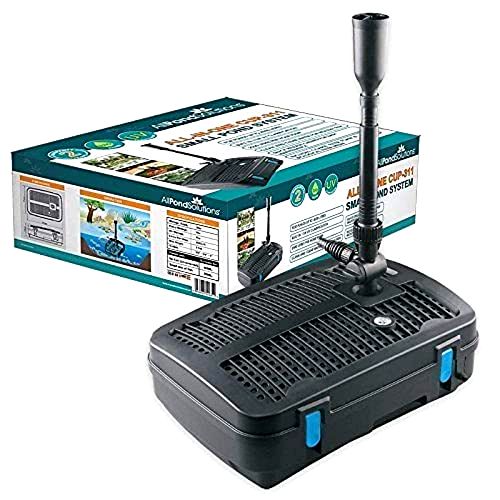
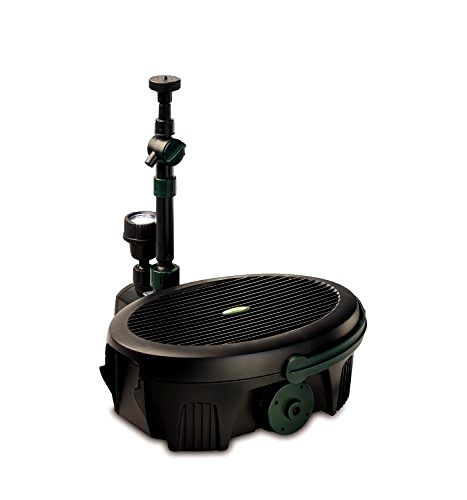
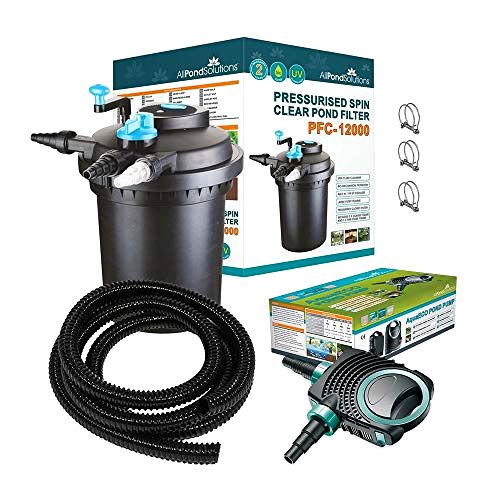
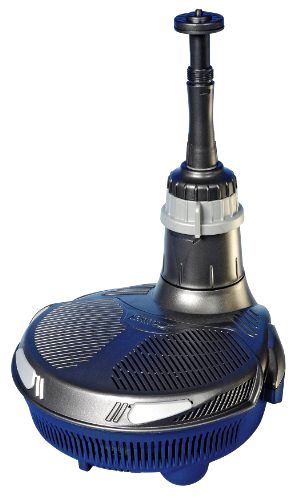
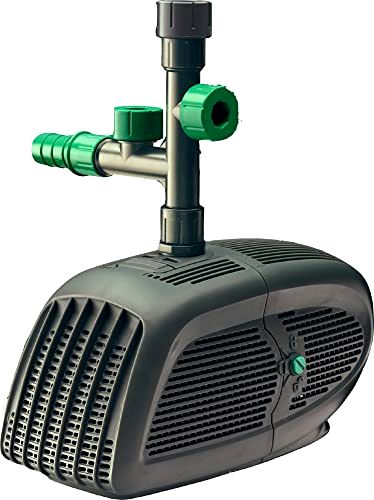
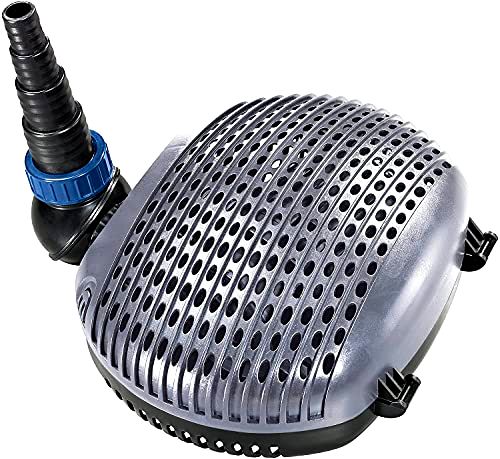
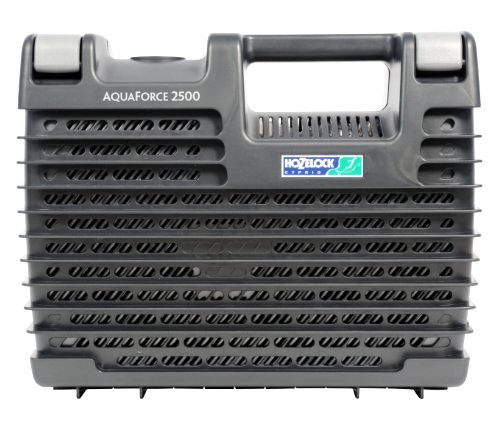

Share